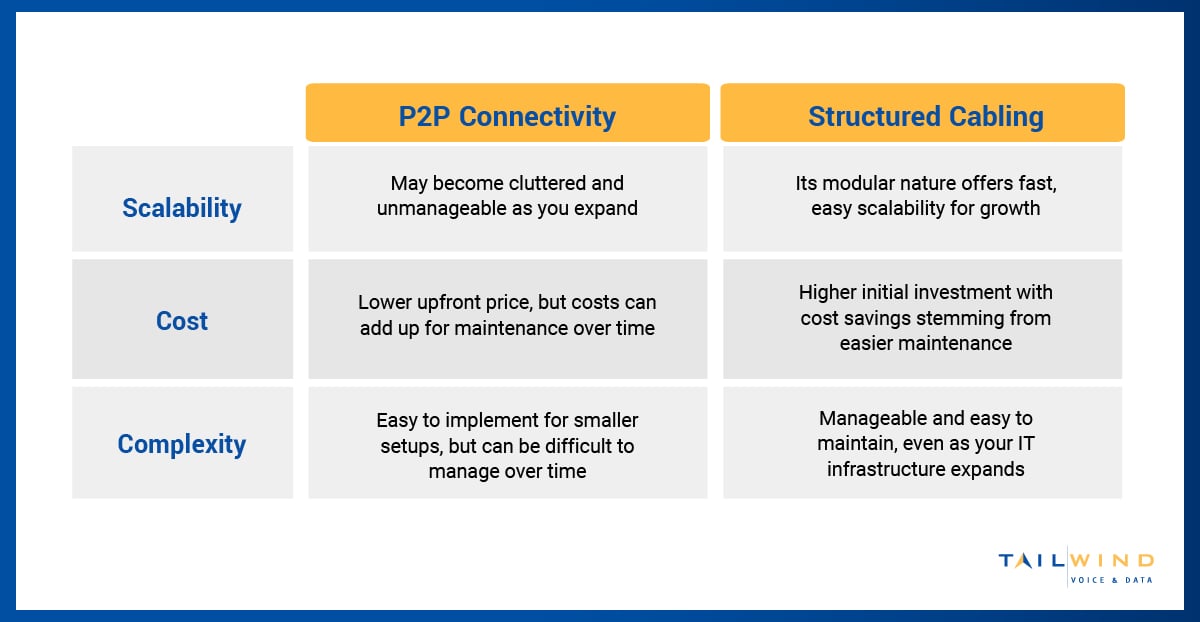A reliable, scalable IT infrastructure is crucial for any business to thrive in today's digital landscape. With the ever-increasing demand for data processing, high-speed connectivity, and seamless technology integration, an efficient cabling system provides a solid foundation for your enterprise now – and room to grow in the future.
When designing and implementing a new network, IT teams must decide between structured cabling and point-to-point (P2P) connectivity. In this blog, we'll explore the differences between these two approaches to help you determine the best fit for your organization.
What Is Structured Cabling?
Structured cabling is an organized, standardized approach to cabling infrastructure. Unlike the more ad hoc P2P setups, a structured cabling system is designed to be more scalable, flexible, and easy to manage.
Structured cabling systems include the cables, hardware, and components that comprise a business’s telecommunications infrastructure. Since this infrastructure handles everything from telephone service to data transmission over your computer network, providing a solid framework with structured cabling should be a top priority.
What Is Point-To-Point Connectivity?
Point-to-point (P2P) connectivity is a simpler, more direct way of connecting two locations. P2P has been the traditional method for connecting switches, servers, and storage units for decades, and businesses typically use it for shorter distances within a single building or across a small campus.
P2P vs. Structured Cabling: Compared
While point-to-point connectivity takes a straightforward approach to connecting devices, structured cabling offers a comprehensive, standardized system for managing your IT infrastructure. There are a few primary differences between these two methods.

Scalability
The modular nature of a structured cabling system allows for easy additions or modifications as your business’s needs change. In contrast, P2P setups can become unmanageable as businesses add more connections, often resulting in a tangled mess of cables.
Structured cabling systems are built with scalability in mind, making it easier to accommodate new technologies, additional devices, or changes in your infrastructure without starting from scratch.
Cost
P2P connectivity might seem like the more cost-effective option compared to implementing a complete structured cabling system. However, the costs of maintaining and modifying a P2P setup can quickly add up as your organization grows, potentially surpassing the initial investment in a structured cabling solution.
Although structured cabling may have higher upfront costs, its standardized approach and components can create long-term cost savings by reducing the time and resources required for troubleshooting, maintenance, and future expansions.
Complexity
Point-to-point connectivity is typically simpler to implement, especially for smaller or more localized setups. But as your network grows in size and complexity, managing and troubleshooting a P2P system can become increasingly difficult and time-consuming.
Structured cabling systems are designed to be more manageable and easier to maintain, even as your IT infrastructure expands. The organized layout makes it simpler to identify and resolve issues, reducing downtime and minimizing the need for costly repairs or replacements.
What Are the Benefits of Structured Cabling Over P2P?
A structured cabling system offers several advantages over point-to-point connectivity, including:
Increased Speed and Bandwidth
Structured cabling systems support higher data transfer rates and increased bandwidth requirements. By adhering to industry standards and leveraging high-quality cabling components, these systems can ensure optimal network performance and minimize bottlenecks – even as your company’s data demands grow.
Easier Management and Troubleshooting
The standardized nature of structured cabling makes it easier to identify, diagnose, and resolve issues within your network infrastructure. When implemented correctly, these systems offer a clear and logical layout for technicians to quickly locate and isolate problems, reducing potential downtime.
Higher Scalability for Future Technologies
Structured cabling systems are easy to scale, allowing for seamless integration of new technologies and expansions to your infrastructure. As your business grows and new standards or devices emerge, a structured cabling system can accommodate changes without the need for overhauls or complete replacements.
Clean and Organized Aesthetic
While it may seem like a minor benefit, the clean aesthetic of a structured cabling system can improve the management and maintenance of your IT infrastructure. Its well-organized layout allows technicians to easily navigate and access equipment, reducing the risk of accidental damage or disruptions.
Improved Safety and Security
Structured cabling systems can improve the safety and security of your IT infrastructure. These systems are designed with proper cable management and grounding techniques, reducing the risk of tripping hazards from loose cables and minimizing the potential for electromagnetic interference (EMI).
Implement a Best-Fit Structured Cabling System With TailWind
Choosing between P2P and structured cabling will ultimately depend on your organization's current IT needs, growth plans, and budget. However, for businesses looking to scale and stay competitive by adopting new technologies, a structured cabling system is likely the best choice.
Implementing structured cabling can be challenging if your in-house IT staff lacks the expertise or resources to tackle the project, but TailWind can help. We’ll manage all aspects of your structured cabling installation project – from design to boots-on-the-ground support – so you never have to worry about wiring for your enterprise.
Ready to upgrade your IT infrastructure? Whether you need to relocate branches, optimize your OSP system, or set up a new construction, our structured cabling experts are here to help. Contact TailWind today to get started.